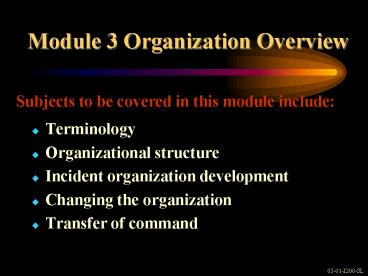Module 3 Organization Overview - PowerPoint PPT Presentation
1 / 35
Title:
Module 3 Organization Overview
Description:
Describe the use of Branches, Divisions, and Groups within the Operations ... Organizational Elements -- e.g., Division, Branch, Unit, etc. ... – PowerPoint PPT presentation
Number of Views:33
Avg rating:3.0/5.0
Title: Module 3 Organization Overview
1
Module 3 Organization Overview
Subjects to be covered in this module include
- Terminology
- Organizational structure
- Incident organization development
- Changing the organization
- Transfer of command
03-01-I200-SL
2
Module 3 Objectives
- Explain how the incident organization expands or
contracts to meet operational needs of the
incident or event - Describe the use of Branches, Divisions, and
Groups within the Operations Section and provide
supervisory titles associated with each level - List the essential elements of information
involved in transfer of command - Match organizational positions with appropriate
ICS section - Describe an ICS organization appropriate to a
small incident using an Incident Briefing Form
03-02-I200-SL
3
Organization Structure
Managerial Level
Command
Section Chief
Directors
Supervisors
Leaders
Units within Planning Logistics Finance/Administra
tion Units
03-03-I200-SL
4
Primary ICS Management Functions
Incident Command
Operations
Logistics
Finance/ Administration
Planning
03-04-I200-SL
5
Two Ways to Organize Incident Command
Incident Command
03-05-I200-SL
6
ICS Terminology is Used For
- Organizational Elements -- e.g., Division,
Branch, Unit, etc. - Position Titles -- e.g., Officer, Director,
Leader, etc. - Facilities -- e.g., Incident Command Post,
Staging Area, etc. - Resources -- e.g., Task Forces, Strike Teams, etc.
03-06-I200-SL
7
Higher Ranking Persons Arriving at an Incident
will
- Assume Command
- Maintain Command
- Reassign Command to a Third Party
03-07-I200-SL
8
Planning
Logistics
Information
Planning
Logistics
Information
Command
Command
Safety
Safety
Operations
Operations
Liaison
Liaison
Finance/ Admin.
Finance/ Admin.
Functional Responsibilities of the Incident
Commander
03-08-I200-SL
9
03-09-I200-SL
10
Reasons to Designate a Deputy IC
- Perform tasks requested by Incident Commander
- Work as relief Incident Commander
- Represent assisting agency as a Deputy IC
03-10-I200-SL
11
The Command Staff
Safety Officer
Liaison Officer
Information Officer
03-11-I200-SL
12
Information Officer
- One per incident
- Central point for information dissemination
03-12-I200-SL
13
Safety Officer
- One per incident
- Anticipate, detect, and correct unsafe situations
- Has emergency authority to stop unsafe acts
03-13-I200-SL
14
Liaison Officer
- Contact point for representatives of assisting
and cooperating agencies - Assisting agency - provides tactical or service
resources - Cooperating agency - provides support other than
tactical or service resources, e.g., Red Cross,
Employment Office, etc.
03-14-I200-SL
15
Agency Representative
- Individual assigned to an incident by an
assisting or cooperating agency - Agency representatives have authority to make
decisions for their agency - Agency representatives report to the Liaison
Officer (if designated) or to the Incident
Commander
03-15-I200-SL
16
Assistant
- A level of technical capability, qualifications,
and responsibility subordinate to primary
positions - Assistants are used as subordinates for the
Command Staff positions, particularly Information
Officer and Safety Officer. Assistants may also
be used at camps to supervise unit activities.
03-16-I200-SL
17
Operations Section
- Directs and coordinates all incident tactical
operations - Organization develops as required
- Organization can consist of
- Single Resources, Task Forces, and Strike Teams
- Staging Areas
- Air Operations
- Divisions, Groups, Branches
03-17-I200-SL
18
Geographic Divisions
03-18-I200-SL
19
Functional Groups
03-19-I200-SL
20
Combined Divisions Groups
03-20-I200-SL
21
Geographic Branches
03-21-I200-SL
22
Staging Area
- Locations to place available resources
- Several staging areas may be used
- Manager reports to IC or Operations Section Chief
- Resources are available on 3-minute notice
- May be relocated
03-22-I200-SL
23
03-23-I200-SL
24
Planning Section
- Maintain resource status
- Maintain situation status
- Prepare Incident Action Plan
- Provide documentation service
- Prepare Demobilization plan
- Provide technical specialists
03-24-I200-SL
25
Planning Section . . .
- May be organized into four positions
- Resources Unit
- Situation Unit
- Documentation Unit
- Demobilization Unit
03-25-I200-SL
26
Logistics Section
- Provides services and support to the incident or
event - Six principal activities
- Two-branch structure if needed
03-26-I200-SL
27
Primary Logistics Section Units
03-27-I200-SL
28
Logistics Branch Structure
- Communications
- Medical
- Food
- Supply
- Facilities
- Ground Support
03-28-I200-SL
29
Finance/AdministrationSection
- Monitors incident costs
- Maintains financial records
- Administers procurement contracts
- Performs time recording
03-29-I200-SL
30
Finance/AdministrationSection
- Time Unit
- Personnel time recording
- Procurement Unit
- Equipment and rental supply contracts
- Compensation/Claims Unit
- Workers comp, records, claims
- Cost Unit
- Collect cost information, provide cost estimates
03-30-I200-SL
31
Guidelines in Developing the ICS Organization
- Establish the Incident Command Post
- Determine organization needs
- Consider needs for Command Staff
- Monitor and maintain span of control
- Demobilize organizational elements when possible
- Avoid combining organizational positions
03-31-I200-SL
32
Planning and Logistics Section
Resources and Ground Support Unit J. Smith
Planning Section J. Smith
Logistics Section J. Smith
Right Way
03-32-I200-SL
33
Transfer of Command Checklist
- Appropriate ICS terminology is used
- Incident Command Post is established
- Face-to-face transfer of command
- Briefing by outgoing Incident Commander
- New Incident Commander assumes command
- Appropriate notifications are made
03-33-I200-SL
34
Transfer of Command Briefing
- Situation status
- Objectives and priorities
- Current organization
- Resource assignments
- Resources en route and/or ordered
- Facilities established
- Communications Plan
- Prognosis, concern-related issues
03-34-I200-SL
35
Module 3 ObjectivesReview
- Explain how the incident organization expands or
contracts to meet operational needs of the
incident or event - Describe the use of Branches, Divisions, and
Groups within the Operations Section and provide
supervisory titles associated with each level - List the essential elements of information
involved in transfer of command - Match organizational positions with appropriate
ICS section - Describe an ICS organization appropriate to a
small incident using an Incident Briefing Form
03-35-I200-SL































